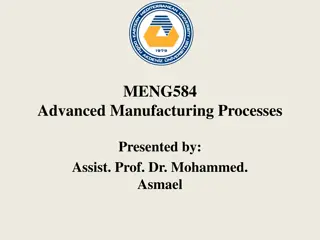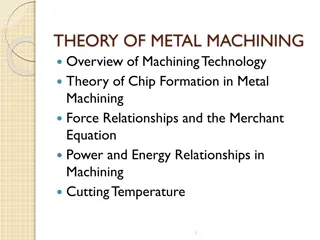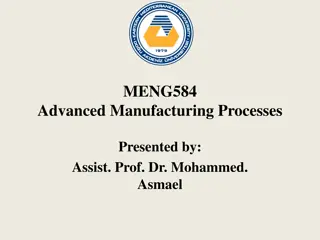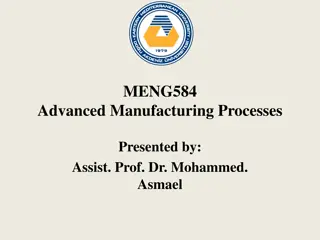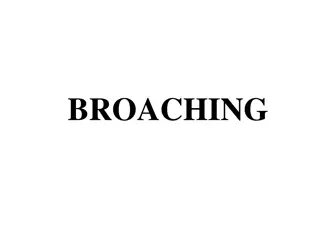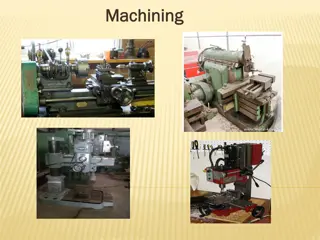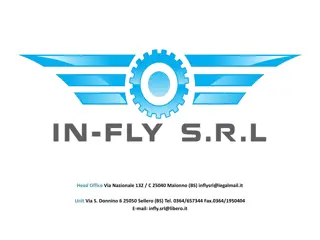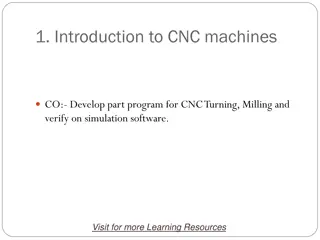Expert Insights: Machining Technology Innovations by Dr. Fayez Abogharbia
Explore advanced drilling techniques in machining technology with insights from Dr. Fayez Abogharbia, an esteemed professor. Learn about double-margin drills for precision, chip-breaker drills to minimize clogging, step drills for multiple-diameter holes, and subland drills for versatile operations in high-production settings.
Download Presentation

Please find below an Image/Link to download the presentation.
The content on the website is provided AS IS for your information and personal use only. It may not be sold, licensed, or shared on other websites without obtaining consent from the author. Download presentation by click this link. If you encounter any issues during the download, it is possible that the publisher has removed the file from their server.
E N D
Presentation Transcript
Machining Technology Dr. Fayez Abogharbia Emeritus Prof.
Chapter 3 Drilling Lecture (2)
Double-margin drills are often used when holes must be straighter and to closer tolerances with respect to size than can normally be obtained with a single-margin drill. They have a second pair of margins at the trailing edges of the lands, about midway between the primary margins, thus providing added bearing in bushings and holes with four guide surfaces. This construction also helps to eliminate the effects of errors in point grinding. Double margins are also used on some step drills for producing accurate holes when guide bushings cannot be used.
Chip-breaker drills have flute modifications or other design features to curl and break the chips produced in most materials in which long, stringy chips are normally produced, thus minimizing clogging problems. Drill points modified to enhance the chip-breaking action are shown below .Such flute designs are built into the drills, and no additional notches or grooves are required when regrinding. Chip-breaker drills cost about 10% more than conventional drills, but the added cost is easily offset by the longer tool life and the time saved from not having the problem of long chips. Tool life increases because of the efficient chip ejection and better penetration of the coolant to the drill tip.
Step drills have two or more diameters, produced by grinding various steps on the diameter of the drill. The steps usually consist of a square or angular cutting edge. Step drills are extensively used in applications requiring multiple-diameter holes. They can be made by grinding steps on common drills; usually, some thinning of the web is required. The simplest form of a step drill is a combination drilling and countersinking tool.
Subland drills are combination tools having separate lands or margins, which extend the full length of the flutes, for each of the two or more diameters. Subland drills perform two or more operations in one pass of the tool. The different diameters or lands can be ground to permit drilling and countersinking for flathead screws, or drilling and counterboring for socket- head screws. Extensive use is made of subland drills in high-production work. Subland drills with as many as four diameters have been successfully used. For optimum results, however, the largest diameter should be no greater than twice the smallest diameter because of the variation in cutting speeds and feeds.
Gun drills, which are used in horizontal deep-hole drilling machines, have a single V-shaped flute; the single cutting face is sharpened offset to form two cutting angles. When drilling, these angles form two chips broken into short lengths for easier expulsion. The drill body is usually a steel tube through which a cutting fluid passes under pressure and in sufficient volume to cool and lubricate the cutting area and flush out chips. To counter the unbalanced cutting force of the single cutting edge, wear pads (usually carbide) are provided in the drill opposite the cutting face to keep the drill on center. Gun drills are used to drill soft as well as hard material.
For accurate holes, gun drills must be used in rigid equipment with a positive feed. With such equipment, gun drilling eliminates the need for subsequent rough and finish reaming. A properly started gun drill guided by a drill bushing will produce a hole that does not drift from the centerline. A spotface or a precision center drill can be used for more accurate starting of a gun drill. For maximum efficiency in gun drilling, the cutting fluid should provide a fluid film between wear pads and work material, prevent welding of chips to the cutting edge of the drill, cool the drill and the work, and dispose of chips by flushing out the hole.
Two types of straight-flute gun drills are used for deep-hole drilling. One type, known as a trepanning drill or a pin-cutting gun drill, has no dead center and leaves a solid core of metal. As the drill advances, the core acts as a continuous center guide at the point where the cutting is done. This prevents the drill from running to one side and the hole accuracy is easier to maintain. The other type, known as a center-cut gun drill, has been the conventional drill for many years. It is still used for much deep-hole drilling, such as the drilling of blind holes where a core-type drill cannot be used.
Gun drills operate at much smaller feeds than conventional twist drills, but the cutting speeds are higher. Each type of drill has only a single cutting edge with a straight flute running throughout its length. The chips are carried out of the hole along the flute of the drill as rapidly as they are formed. Gun drilling is especially well suited to producing long holes to close tolerances. In some applications, such as the drilling of deep blind holes, gun drilling may be the only practical method of drilling a hole to concentricity tolerances.


